The global industrial traction battery market is projected to grow from USD 5.3 billion in 2025 to approximately USD 19.5 billion by 2035, recording an absolute increase of USD 14.2 billion over the forecast period. This translates into a total growth of 267.7%, with the market forecast to expand at a CAGR of 13.9% between 2025 and 2035. The overall market size is expected to grow by nearly 3.68X during the same period, supported by increasing adoption of electric material handling equipment, rising demand for environmentally-friendly industrial solutions, and increasing focus on operational efficiency and total cost of ownership in warehouse and logistics operations.
Between 2025 and 2030, the industrial traction battery market is projected to expand from USD 5.3 billion to USD 10.7 billion, resulting in a value increase of USD 5.4 billion, which represents 38% of the total forecast growth for the coming years. This phase of development will be shaped by the accelerating transition to electric material handling equipment, increasing adoption of lithium-ion technology in industrial applications, and growing penetration of automated warehouse solutions requiring advanced battery technologies. Battery manufacturers are expanding their industrial traction battery product portfolios to address the growing demand for high-performance and long-lasting power solutions in material handling and industrial vehicle applications.
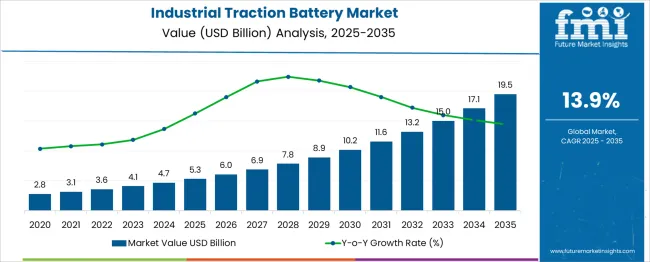
| Metric | Value |
|---|---|
| Estimated Value in (2025E) | USD 5.3 billion |
| Forecast Value in (2035F) | USD 19.5 billion |
| Forecast CAGR (2025 to 2035) | 13.9% |
From 2030 to 2035, the market is forecast to grow from USD 10.7 billion to USD 19.5 billion, adding another USD 8.8 billion, which constitutes 62% of the ten-year expansion. This period is expected to be characterized by the expansion of opportunity charging and fast-charging battery technologies, integration of smart battery management systems with IoT connectivity, and development of next-generation battery chemistries with enhanced performance characteristics. The growing adoption of autonomous material handling equipment and Industry 4.0 integration will drive demand for industrial traction batteries with advanced monitoring capabilities and predictive maintenance features.
Between 2020 and 2025, the industrial traction battery market experienced a significant transformation, driven by an increasing shift toward electric material handling equipment and growing recognition of the operational and environmental benefits of advanced battery technologies. The market developed as industrial operators recognized the superior performance characteristics and total cost of ownership advantages of modern traction batteries over traditional power sources. Warehouse automation and e-commerce growth began emphasizing the critical importance of reliable and efficient battery-powered industrial vehicles for operational productivity.
Market expansion is being supported by the increasing transition to electric material handling equipment and the corresponding demand for advanced battery technologies that can provide superior performance, longer operating time, and reduced maintenance requirements. Modern industrial operators are increasingly focused on improving operational efficiency while reducing environmental impact and total cost of ownership. Industrial traction batteries' proven ability to deliver consistent power, extended cycle life, and opportunity charging capabilities makes them essential components of modern warehouse and material handling operations.
The growing focus on automation and smart warehouse technologies is driving demand for industrial traction batteries that can support continuous operation, fast charging, and integration with fleet management systems. Industrial operators' preference for battery solutions that combine high energy density with reliable performance and minimal maintenance is creating opportunities for advanced lithium-ion and next-generation battery technologies. The rising influence of initiatives and environmental regulations is also contributing to increased adoption of electric industrial vehicles powered by advanced traction battery systems.
The market is segmented by chemistry, application, and region. By chemistry, the market is divided into lithium-ion, lead acid, nickel-based, and others. Based on application, the market is categorized into forklifts, railroads, and others. Regionally, the market is divided into North America, Europe, East Asia, South Asia & Pacific, Latin America, and the Middle East & Africa.

The lithium-ion chemistry segment is projected to account for 60.4% of the industrial traction battery market in 2025, reaffirming its position as the dominant battery technology. Industrial operators increasingly prefer lithium-ion batteries for their superior energy density, longer cycle life, and opportunity charging capabilities that enable continuous operation without battery swapping. Lithium-ion batteries' proven advantages in reducing downtime, minimizing maintenance requirements, and providing consistent power output directly address industrial operational demands for maximum productivity and cost efficiency.
This battery chemistry forms the foundation of modern material handling operations, as it represents the most advanced and performance-oriented solution for demanding industrial applications. Manufacturer investments in lithium-ion technology development and ongoing improvements in battery management systems continue to strengthen market adoption. With industrial operators prioritizing operational efficiency and total cost of ownership, lithium-ion batteries align with both performance requirements and economic objectives, making them the central driver of industrial traction battery market growth.
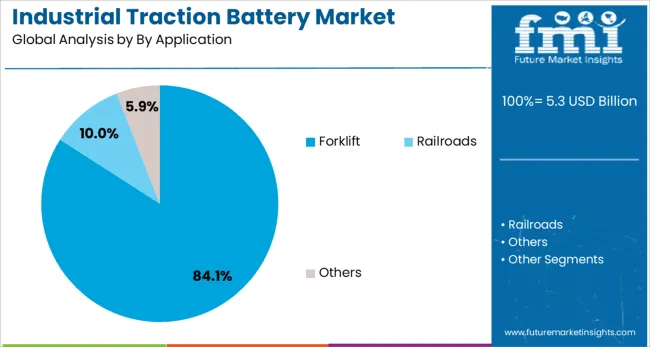
Forklift applications are projected to represent 84.1% of industrial traction battery demand in 2025, underscoring their critical role as the primary application for traction battery technology. Industrial operators prefer electric forklifts powered by advanced traction batteries for their ability to provide clean, quiet, and efficient material handling in warehouse and manufacturing environments. Positioned as essential equipment for modern logistics operations, electric forklifts offer both operational advantages and environmental benefits compared to internal combustion alternatives.
The segment is supported by increasing warehouse automation and growing e-commerce logistics requirements that demand reliable and efficient material handling equipment. Industrial operators are investing in electric forklift fleets to reduce emissions, improve indoor air quality, and comply with environmental regulations. As logistics operations prioritize efficiency, forklift traction batteries will continue to dominate the market while supporting the transition to cleaner and more efficient material handling solutions.
The industrial traction battery market is advancing rapidly due to increasing adoption of electric material handling equipment and growing focus on operational efficiency and Ecological balance in industrial operations. The market faces challenges, including high initial investment costs, infrastructure requirements for charging systems, and technical complexity of battery management systems. Innovation in battery chemistry and charging technologies continues to influence product development and market expansion patterns.
The growing adoption of automated warehouse systems and expanding e-commerce logistics operations are enabling increased deployment of electric material handling equipment that requires advanced traction battery solutions. Automated warehouses demand reliable and consistent power sources for the continuous operation of robotic systems and material handling equipment. Industrial operators are increasingly recognizing the operational advantages of battery-powered equipment in automated environments.
Modern industrial traction battery manufacturers are incorporating advanced battery management systems, IoT connectivity, and predictive analytics capabilities to optimize battery performance and maintenance scheduling. These technologies improve operational efficiency while providing real-time monitoring and fleet management capabilities. Advanced battery systems also enable integration with warehouse management systems and predictive maintenance programs for optimized equipment utilization.
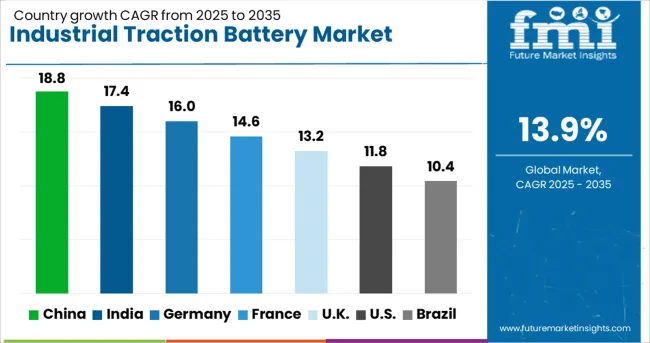
| Countries | CAGR (2025-2035) |
|---|---|
| China | 18.8% |
| India | 17.4% |
| Germany | 16% |
| France | 14.6% |
| UK | 13.2% |
| USA | 11.8% |
| Brazil | 10.4% |
The industrial traction battery market is experiencing exceptional growth globally, with China leading at an 18.8% CAGR through 2035, driven by massive manufacturing expansion, rapidly growing e-commerce logistics sector, and increasing adoption of electric industrial vehicles. India follows closely at 17.4%, supported by an expanding manufacturing industry, growing warehouse automation, and rising adoption of electric material handling equipment. Germany shows strong growth at 16%, emphasizing advanced manufacturing and industrial automation excellence. France records 14.6%, focusing on logistics efficiency and industrial practices. The UK shows 13.2% growth, prioritizing e-commerce infrastructure and warehouse modernization.
The report covers an in-depth analysis of 40+ countries; seven top-performing countries are highlighted below.
Revenue from industrial traction batteries in China is projected to exhibit exceptional growth with a CAGR of 18.8% through 2035, driven by massive manufacturing capacity expansion and rapidly growing e-commerce logistics infrastructure requiring advanced material handling solutions. The country's position as a global manufacturing hub and expanding domestic logistics market are creating significant demand for electric industrial vehicles and advanced traction battery technologies. Major domestic and international battery manufacturers are establishing comprehensive production and technology development capabilities to serve the expanding industrial market.
Revenue from industrial traction batteries in India is expanding at a CAGR of 17.4%, supported by the rapidly growing manufacturing sector, expanding warehouse infrastructure, and increasing adoption of electric material handling equipment in industrial operations. The country's developing logistics industry and rising focus on operational efficiency are driving demand for advanced traction battery solutions. International battery manufacturers and domestic companies are establishing comprehensive manufacturing and service capabilities to address the growing demand for industrial battery technologies.
Demand for industrial traction batteries in Germany is projected to grow at a CAGR of 16%, supported by the country's leadership in advanced manufacturing and strong focus on industrial automation and efficiency optimization. German industrial operators consistently demand high-performance traction batteries that meet stringent quality requirements and provide superior reliability for critical material handling applications.
Revenue from industrial traction batteries in France is projected to grow at a CAGR of 14.6% through 2035, driven by the country's advanced logistics sector and focus on industrial innovation. French industrial operators consistently demand high-quality traction battery solutions that deliver superior performance while supporting operational efficiency and environmental responsibility.
Revenue from industrial traction batteries in the UK is projected to grow at a CAGR of 13.2% through 2035, supported by strong e-commerce sector expansion and focus on warehouse automation and efficiency improvement. British industrial operators value operational efficiency, technology integration, and proven performance, positioning advanced traction batteries as essential components of modern material handling and logistics operations.

Revenue from industrial traction batteries in the USA is projected to grow at a CAGR of 11.8% through 2035, supported by the country's leadership in industrial technology innovation, established manufacturing sector, and preference for advanced material handling solutions. American industrial operators prioritize operational efficiency, technology integration, and proven performance, making advanced traction batteries a preferred choice in warehouse and manufacturing applications.
Revenue from industrial traction batteries in Brazil is projected to grow at a CAGR of 10.4% through 2035, supported by the expanding manufacturing sector, growing logistics infrastructure, and increasing adoption of electric material handling equipment in industrial operations. The country's developing industrial base and rising focus on operational efficiency are creating significant opportunities for traction battery market growth. International battery manufacturers and domestic distributors are establishing comprehensive service capabilities to serve the growing demand for industrial battery solutions.
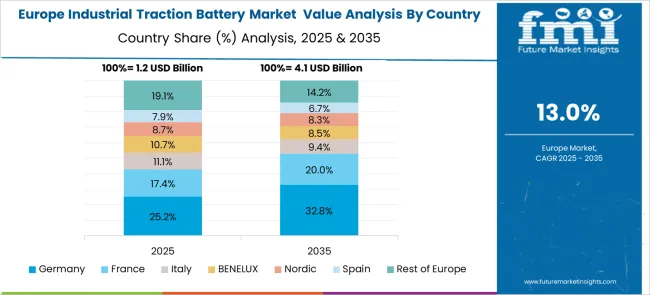
The industrial traction battery market in Europe demonstrates advanced development across major economies, with Germany showing a strong presence through its manufacturing industry expertise and focus on industrial automation and efficiency, supported by companies leveraging engineering excellence to implement high-performance traction battery solutions that emphasize reliability, efficiency, and advanced technology integration in material handling and industrial vehicle applications. France represents a significant market driven by its logistics sector development and sophisticated understanding of warehouse automation requirements, with companies focusing on advanced traction battery solutions that combine French industrial expertise with cutting-edge battery technologies for enhanced operational efficiency in material handling and automated warehouse applications.
The UK exhibits considerable growth through its focus on logistics efficiency and e-commerce infrastructure development, with strong adoption of electric material handling equipment and advanced traction battery systems in warehouses, distribution centers, and manufacturing facilities. Germany and France show expanding interest in lithium-ion traction battery applications, particularly in automated material handling systems and high-performance industrial vehicle applications. BENELUX countries contribute through their focus on logistics innovation and industrial practices. At the same time, Eastern Europe and the Nordic regions display growing potential driven by increasing industrial automation and expanding adoption of electric material handling equipment.
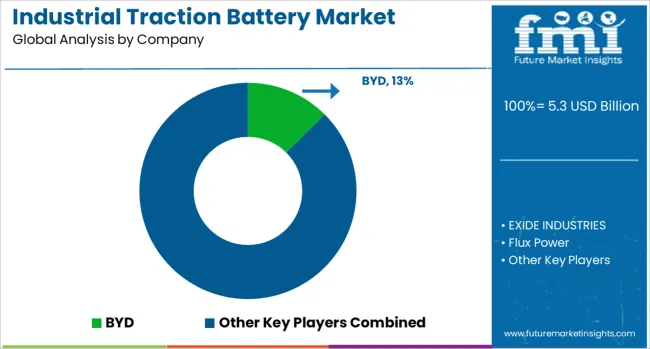
The industrial traction battery market is characterized by competition among established battery manufacturers, specialized industrial battery companies, and emerging energy storage solution providers. Companies are investing in advanced battery chemistry research, manufacturing capacity expansion, product innovation, and comprehensive service networks to deliver reliable, high-performance, and cost-effective traction battery solutions for industrial applications. Technology leadership, product quality, and customer support are central to strengthening market position and customer relationships.
BYD leads the market with significant global market share, offering comprehensive lithium-ion traction battery solutions with a focus on energy density and operational efficiency. EXIDE INDUSTRIES provides established lead acid and advanced battery technologies with focus on industrial applications and market reach. Flux Power delivers specialized lithium-ion solutions with a focus on material handling equipment applications. Sunlight Group offers comprehensive traction battery solutions with focus on European market expertise.
ENERSYS provides industrial battery solutions with a focus on reliability and performance across multiple applications. East Penn delivers comprehensive battery manufacturing with a focus on industrial and commercial markets. ecovolta, Farasis Energy, and Guoxuan High-tech Power Energy offer specialized lithium-ion technologies with a focus on performance optimization. HOPPECKE Batteries, Hitachi Energy, Mutlu Corporation, MIDAC, Sunwoda Electronic, Toshiba Corporation, and Amara Raja Batteries provide comprehensive industrial traction battery solutions and services for diverse market segments and geographic regions.
| Items | Values |
|---|---|
| Quantitative Units (2025) | USD 5.3 billion |
| Chemistry | Lithium-Ion, Lead Acid, Nickel-Based, Others |
| Application | Forklift, Railroads, Others |
| Regions Covered | North America, Europe, East Asia, South Asia & Pacific, Latin America, Middle East & Africa |
| Countries Covered | United States, Canada, United Kingdom, Germany, France, China, Japan, South Korea, India, Brazil, Australia, and 40+ countries |
| Key Companies Profiled | BYD, EXIDE INDUSTRIES, Flux Power, Sunlight Group, ENERSYS, East Penn, ecovolta, Farasis Energy, Guoxuan High-tech Power Energy, HOPPECKE Batteries, Hitachi Energy, Mutlu Corporation, MIDAC, Sunwoda Electronic, Toshiba Corporation, and Amara Raja Batteries |
| Additional Attributes | Dollar sales by chemistry type and application category, regional demand trends, competitive landscape, buyer preferences for lithium-ion versus traditional battery chemistries, integration with fleet management systems, innovations in battery management technology, fast charging advancement, and smart battery solution development |
North America
Europe
East Asia
South Asia & Pacific
Latin America
Middle East & Africa
The global industrial traction battery market is estimated to be valued at USD 5.3 billion in 2025.
The market size for the industrial traction battery market is projected to reach USD 19.5 billion by 2035.
The industrial traction battery market is expected to grow at a 13.9% CAGR between 2025 and 2035.
The key product types in industrial traction battery market are lithium-ion, lead acid, nickel-based and others.
In terms of by application, forklift segment to command 84.1% share in the industrial traction battery market in 2025.






Our Research Products

The "Full Research Suite" delivers actionable market intel, deep dives on markets or technologies, so clients act faster, cut risk, and unlock growth.

The Leaderboard benchmarks and ranks top vendors, classifying them as Established Leaders, Leading Challengers, or Disruptors & Challengers.

Locates where complements amplify value and substitutes erode it, forecasting net impact by horizon

We deliver granular, decision-grade intel: market sizing, 5-year forecasts, pricing, adoption, usage, revenue, and operational KPIs—plus competitor tracking, regulation, and value chains—across 60 countries broadly.

Spot the shifts before they hit your P&L. We track inflection points, adoption curves, pricing moves, and ecosystem plays to show where demand is heading, why it is changing, and what to do next across high-growth markets and disruptive tech

Real-time reads of user behavior. We track shifting priorities, perceptions of today’s and next-gen services, and provider experience, then pace how fast tech moves from trial to adoption, blending buyer, consumer, and channel inputs with social signals (#WhySwitch, #UX).

Partner with our analyst team to build a custom report designed around your business priorities. From analysing market trends to assessing competitors or crafting bespoke datasets, we tailor insights to your needs.
Supplier Intelligence
Discovery & Profiling
Capacity & Footprint
Performance & Risk
Compliance & Governance
Commercial Readiness
Who Supplies Whom
Scorecards & Shortlists
Playbooks & Docs
Category Intelligence
Definition & Scope
Demand & Use Cases
Cost Drivers
Market Structure
Supply Chain Map
Trade & Policy
Operating Norms
Deliverables
Buyer Intelligence
Account Basics
Spend & Scope
Procurement Model
Vendor Requirements
Terms & Policies
Entry Strategy
Pain Points & Triggers
Outputs
Pricing Analysis
Benchmarks
Trends
Should-Cost
Indexation
Landed Cost
Commercial Terms
Deliverables
Brand Analysis
Positioning & Value Prop
Share & Presence
Customer Evidence
Go-to-Market
Digital & Reputation
Compliance & Trust
KPIs & Gaps
Outputs
Full Research Suite comprises of:
Market outlook & trends analysis
Interviews & case studies
Strategic recommendations
Vendor profiles & capabilities analysis
5-year forecasts
8 regions and 60+ country-level data splits
Market segment data splits
12 months of continuous data updates
DELIVERED AS:
PDF EXCEL ONLINE
Industrial Grade Electrochemical CO Sensor Market Size and Share Forecast Outlook 2025 to 2035
Industrial Bench Scale Market Size and Share Forecast Outlook 2025 to 2035
Industrial Low Profile Floor Scale Market Size and Share Forecast Outlook 2025 to 2035
Industrial Sand Mill Market Size and Share Forecast Outlook 2025 to 2035
Industrial Control Network Modules Market Size and Share Forecast Outlook 2025 to 2035
Industrial Precision Oven Market Size and Share Forecast Outlook 2025 to 2035
Industrial Water Chiller for PCB Market Size and Share Forecast Outlook 2025 to 2035
Industrial & Commercial HVLS Fans Market Size and Share Forecast Outlook 2025 to 2035
Industrial Robot Controller Market Size and Share Forecast Outlook 2025 to 2035
Industrial Wired Routers Market Size and Share Forecast Outlook 2025 to 2035
Industrial Evaporative Condensers Market Size and Share Forecast Outlook 2025 to 2035
Industrial Energy Management System Market Size and Share Forecast Outlook 2025 to 2035
Industrial Insulation Market Size and Share Forecast Outlook 2025 to 2035
Industrial Safety Gloves Market Size and Share Forecast Outlook 2025 to 2035
Industrial Cleaner Market Size and Share Forecast Outlook 2025 to 2035
Industrial Dust Treatment System Market Size and Share Forecast Outlook 2025 to 2035
Industrial Vertical Washing Tower Market Size and Share Forecast Outlook 2025 to 2035
Industrial Pepper Market Size and Share Forecast Outlook 2025 to 2035
Industrial Electronics Packaging Market Forecast and Outlook 2025 to 2035
Industrial Absorbent Market Forecast and Outlook 2025 to 2035

Thank you!
You will receive an email from our Business Development Manager. Please be sure to check your SPAM/JUNK folder too.
Chat With
MaRIA